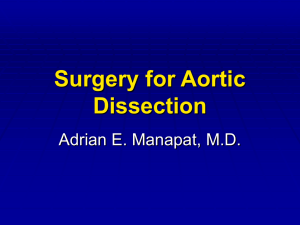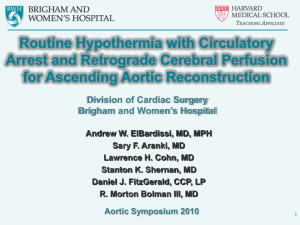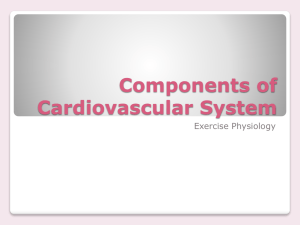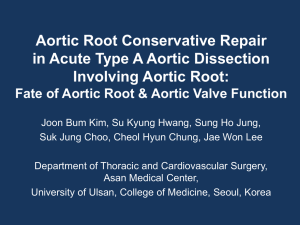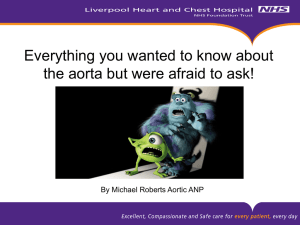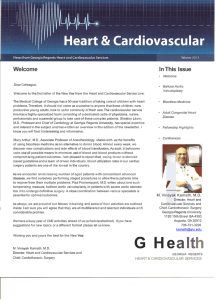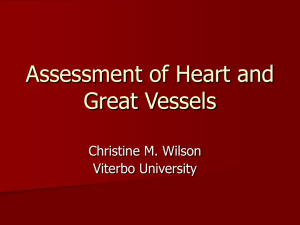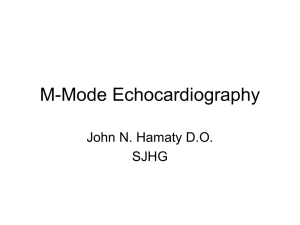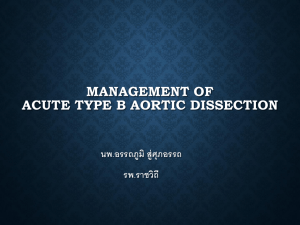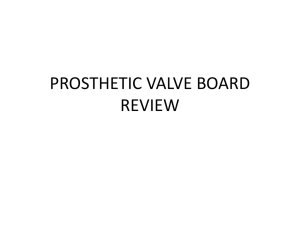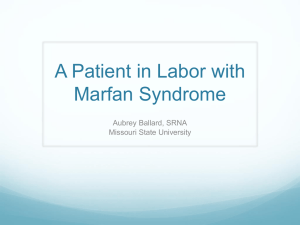Intra-thoracic Complications of Solid Abdominal
advertisement
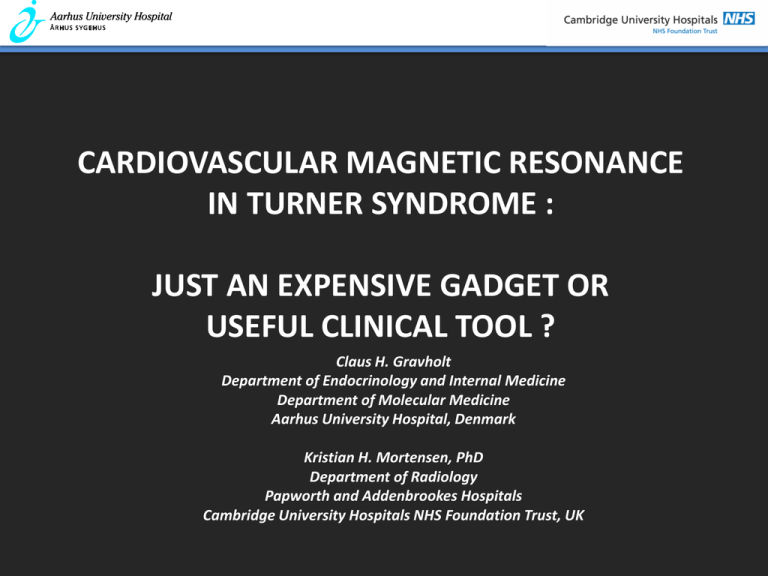
CARDIOVASCULAR MAGNETIC RESONANCE IN TURNER SYNDROME : JUST AN EXPENSIVE GADGET OR USEFUL CLINICAL TOOL ? Claus H. Gravholt Department of Endocrinology and Internal Medicine Department of Molecular Medicine Aarhus University Hospital, Denmark Kristian H. Mortensen, PhD Department of Radiology Papworth and Addenbrookes Hospitals Cambridge University Hospitals NHS Foundation Trust, UK 3-FOLD INCREASED RISK OF EARLY DEATH : HALF ATTRIBUTED TO CARDIOVASCULAR DISEASE ACQUIRED CONGENITAL Accounts for 41% of all-cause excess mortality Accounts for 8% of all-cause excess mortality Price [1986]; Schoemaker [2008]; Gravholt [1998]; Stochholm [2006] CLEARY ABNORMAL PHENOTYPE : DOES THIS KNOWLEDGE HELP PATIENTS ? Intima media thickness Arterial diameter Augmentation index Ambulatory arterial stiffness index Arterial distensibility QT-interval Exercise capacity VO2 max Left ventricular function Left ventricular mass Left atrial size Blood pressure Heart rate Serum Cholesterol Inflammatory markers Sympathovagal balance … NO OUTCOME STUDIES : NO VALIDATED MARKERS : FEW PROSPECTIVE STUDIES NECESSARY BULDING STONES TO IMPROVE UNDERSTANDING OF DISEASE PROCESSES IN TS, .. But how to TRANSLATE INTO CLINICAL ? Baguet [2005]; Landin-Wilhelmsen [2001]; Nathwani [2000]; Andersen [2008]; Bondy [2006]; Pirgon [2008]; Ostberg [2005] DIGGING DEEPER : PREVENTING AORTIC EVENTS ? AORTIC DISSECTION TS = INDEPENDENT MARKER : WITHIN TURNER SYNDROME ? FREQUENT OCCURENCES >< INFREQUENT OVERALL 2:100 ≈ 100-fold increased risk 2/3 Ascending // 1/3 Descending Aortic dilation Aortic coarctation, Bicuspid aortic valves Hypertension, karyotype, pregnancy > 10% : not predicted Lopez [2007]; Gravholt [2006]; Carlson [2009]; Carlson [2012] WHO, WHEN, WHAT, HOW TO MONITOR AND INTERVENE ? ‘Patients with Turner syndrome should undergo imaging of the heart and aorta for evidence of bicuspid aortic valve, coarctation of the aorta, or dilatation of the ascending thoracic aorta. If initial imaging is normal and there are no risk factors for aortic dissection, repeat imaging should be performed every 5 to 10 years or if otherwise clinically indicated. If abnormalities exist, annual imaging or follow-up imaging should be done. (Level of Evidence: C)’ Although TTE is noninvasive, its failure to visualize consistently and measure accurately the tubular portion of the ascending thoracic aorta is problematic. It is not typically used to follow aneurysms in that aortic segment. However, because TTE does accurately visualize the aortic root, its primary role as an imaging method for serial follow-up is in patients with aortic disease limited to the root, particularly those with Marfan syndrome. It is also used, often in conjunction with CT or MR, to observe patients with concomitant structural heart disease, such as bicuspid aortic valve, mitral valve prolapse, cardiomegaly, or cardiomyopathy. 2010 ACCF/AHA/AATS/ACR/ASA/SCA/SCAI/SIR/STS/SVM Guidelines Hiratzka [2010] THE EASY ANSWER .. HOW TO OPTIMALLY IMAGE ? MRI RADIATION FREE SENSITIVE + SPECIFIC REPEATABLE NON-INVASIVE ECHO CXR AORTOGRAPHY MDCT The same patient with ascending aortic dilation (arrows) secondary to severe aortic valve stenosis. THE GOLD STANDARD : ESCAPING ANATOMICAL PLANES THE GOLD STANDARD : ADAPTABLE TO PATIENT NONCONTRAST 3D 3D 2D 2D FUNCTIONAL DATA CONTRAST ENHANCED IMAGING THE GOLD STANDARD : IS A DIAMETER A DIAMETER ? 3D Multiplaner Imaging THE HARDER QUESTION … DEFINING DISEASE THAT TENDS TO BE CLINICALLY SILENT ANUERYSM: SURGICAL MORTALITY MORTALITY WITH AORTIC DISSECTION Elective surgery: 9.0 % 22% pre-hospital mortality 34% 30-day in-hospital mortality Aortic diameter : only validated risk marker Good positive predictive value (incremental risk with size) poor negative predictive value (cut off work poorly) Turner syndrome : irrespective of BSA correction or not : same issues Olsson [2010]. THE HARDER QUESTION … DEFINING DISEASE COMPARISON WITH HEALTHY FEMALES Aortic dissection strikes at diameters that are ‘normal’ even after BSA correction Patterns of disease and samples of tissue: not just accelerated ageing Poor discriminator ≈ 50% will have an aortic diameter that would be defined as dilated Highly abnormal phenotype : hazardous to deduct COMPARISON WITHIN TURNER SYNDROME But, … no normal data and what is the true risk of aortic events in relation to this? Proposed threshold : 2.5 cm/m2 : 3 events (44, 47 and 57 years of age) with 486 years at risk Supported by retrospective volunteer registry study of 20 aortic dissections More systematic, prospective studies are pivotal Gravholt [2006]; Matura [2007]; Carlson [2012] AWAITING HARD ENDPOINT STUDY : OPTIMISING CLINICAL DATA USAGE ‘Patients with a growth rate of more than 0.5 cm/year in an aorta that is less than 5.5 cm in diameter should be considered for operation. (Level of Evidence: C)’ 2010 ACCF/AHA/AATS/ACR/ASA/SCA/SCAI/SIR/STS/SVM Guidelines CROSS-SECTIONAL + PROSPECTIVE REGISTRATION : ISSUES >50% will have aortic dilatation at one or more points Accelerated growth rates comparable to bicuspid aortic valve and at least double of background population >2.5cm/m2 threshold 0.1 - 0.4 mm/year What are we triaging for … surgery ? … medicine ? … more follow-up (for what again) ? Lanzarini [2007], Mortensen [2011]; Hiratzka [2010] CAN WE APPROACH THE NORMATIVE MRI DATA IN A WAY THAT MAY BETTER THE TELL US ABOUT HOW AN INDIVIDUAL ENCOUNTERED IN CLINICAL PRACTICE MAY COMPARE WITH THEIR PEERS WITH TURNER SYNDROME ? AORTIC MRI: PROSPECTIVE KNOWLEDGE NON-CONTRAST 3D MRI 102 included at baseline Post-operative death: aortic aneurism repair [1] Sudden unexplained death [2] Stanford type A dissection [1] Severe Aortic valve stenosis for valve replacement [1] 89% for follow-up Death of gastric cancer [1] Severe mitral vale regurgitation for surgery [1] 82% for end-of-study Study of aortic diameter at 9 positions from aortic sinuses to diaphragmatic aorta 10 minute study Free breathing Well-tolerated (100%) Olsson [2010]. AORTIC MRI: MODELLING AORTIC DIAMETER >2000 MEASUREMENTS >280 MRI STUDIES 4.8 ± 0.5 YEARS FOLLOW-UP ON AVERAGE CURRENT + FUTURE DIAMETER Mortensen et al, J Cardiovasc Magn Res, 14 PERCIEVED LOW RISK CROSS-SECTIONAL PROSPECTIVE Dots = actual Line = predicted 26-year old / 45,X Tricuspid aortic valve + no aortic coarctation No antihypertensive treatment ABP 104/66 mm Hg BSA 1.46 m2 Mortensen et al, J Cardiovasc Magn Res, 15:47, 2013 Dots = actual at 4 years Line = predicted at 4 years Line = predicted at 8 years PERCIEVED HIGH RISK CROSS-SECTIONAL Dots = actual Line = predicted 49 years old / 45,X/46,X,r(X) bicuspid valves + aortic coarctation On antihypertensive treatment ABP 124/67 mm Hg BSA 1.60 m2 Mortensen et al, J Cardiovasc Magn Res, 15:47, 2013 PROSPECTIVE Dots = actual at 4 years Line = predicted at 4 years Line = predicted at 8 years SIGNIFICANCE : ABOVE NORM ± DEVIATING CROSS-SECTIONAL PROSPECTIVE Dots = actual Line = predicted 43 years old / 45,X bicuspid aortic valve / no coarcation Antihypertensive treatments ABP 143/90 mm Hg BSA 1.47 m2 Mortensen et al, J Cardiovasc Magn Res, 15:47, 2013 Dots = actual at 4 years Line = predicted at 4 years Line = predicted at 8 years Case • Turner syndrome mosaic • Bicuspid aortic valve – operated at the age of 4 month due to stenosis • Just referred to us – followed at another department during childhood • Normotensive • Echo: moderate stenosis (gradient 30 mmHg). Aortic ecatsia in ascending aorta (4 cm), no coarctation – the rest of the aorta is normal MR • Aortic ectasia with a maximum of 4.5 cm (Position 4) • Somewhat ectatic truncus brachiocephalicus • H: 154, W: 76, BSA 1,74 • Indexed aortic size: 2.58 cm/m2 In our model she grossly exceeds the range 40.0 35.0 30.0 25.0 20.0 15.0 10.0 5.0 0.0 1 2 3 4 5 6 7 Mortensen et al. J Cardiovasc Magn Reson. 2013 Jun 6;15(1):47. 8 9 FURTHER STUDY OF THE IMPACT OF RISK FACTOR : % INFLUENCE IN AORTIC DIAMTER Variable Aortic coarctation Age BITRI Antihypertensive treatment Aortic sinus 4.42 0.30 10.39 -4.02 Sinotubular junction -1.54 0.31 13.76 -0.74 Mid-ascending aorta -5.81 0.60 19.03 -0.99 Distal ascending aorta -3.10 0.45 8.12 0.31 Proximal aortic arch -6.73 0.34 8.39 -1.15 Mid aortic arch -5.66 0.09 0.80 -0.77 Distal transverse aortic arch -1.70 0.26 2.41 0.55 Proximal descending 23.40 0.07 5.19 -1.39 Distal descending aorta 14.43 0.34 4.77 1.00 P value <0.0001 <0.0001 0.0004 0.005 Position First indication that antihypertensive treatment works, .. Mortensen et al, J Cardiovasc Magn Res, 15:47, 2013 BUT (!) IT’S NOT ALL ABOUT DIAMETER ESSENTIAL TO COMBINE QUALITATIVE + QUANTITATIVE All-in-one package with MRI? Exploring old and developing new areas, .. FLOW PATTERNS AND WALL PROPERTIES : CAUSE OR EFFECT Wall shear stress and oscillatory sheer stress are altered in dilated aortas compared with normal Altered flow patterns in dilated or obstructive aortopathy : vortices and helices Wall shear stress? Pulse wave velocity? Oscillatory shear stress? Changing flow patterns over time? Unpublished Quantitative measures? Burk [2012] AORTOPATHY GUIDELINES 2010 BASELINE screening All Beyond dissection .. ANNUAL screening Bicuspid aortic valve Aortic coarctation Aortic dilation Dilation and aneurism?? Aortic growth?? Indication for medical prophylaxis?? Indication for surgical prophylaxis?? Risk of surgery? 5-10 YEARS screening Other BEYOND AORTA: LEFT VENTRICULAR CARDIOMYOPATHY T1 MAPPING – NON-CONTRAST : MYOCARDIAL FIBROSIS Left ventricular function – diastolic dysfunction and perturbed myocardial metabolism ? RED = ABNORMAL (HIGH T1) GREEN = NORMAL Underlying processes in TS, .. ischemia, increased afterload, insulin resistance, growth hormone deficiency, thyroid ?? T1 values are closely associated with not only left ventricular systolic and diastolic function but also metabolism in early diabetics, and predicts mortality in aortic stenosis. Jellis [2011]; Dweck [2011] Thank you
